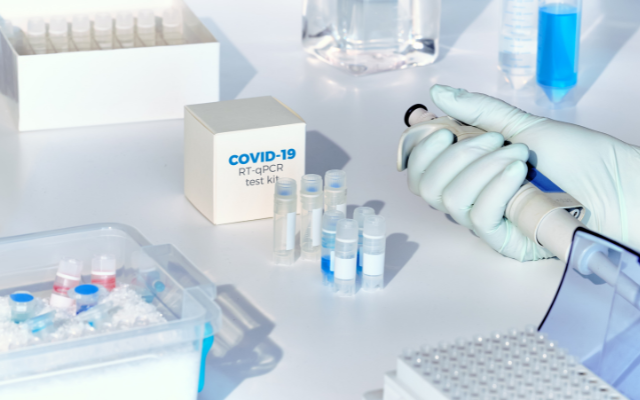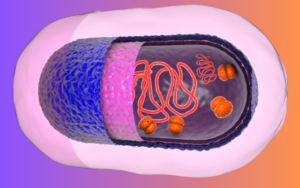In the wake of the global COVID-19 pandemic, one of the most widely used diagnostic tools has been the Reverse Transcription Polymerase Chain Reaction (RT-PCR). This remarkable technology plays a crucial role in identifying and controlling the spread of the virus. In this blog post, we delve into the world of RT-PCR, explaining its principles, applications, and significance in the fight against infectious diseases. Let’s embark on this scientific journey and demystify the complexities of RT-PCR!
Table of Contents
What is RT-PCR?

RT-PCR, which stands for Reverse Transcription Polymerase Chain Reaction, is a cutting-edge molecular biology technique with a pivotal role in COVID-19 testing and various other diagnostic applications. This powerful method involves the detection of viral RNA in patient samples to identify the presence of infectious agents accurately. The process of RT-PCR entails two main steps: reverse transcription and polymerase chain reaction. During reverse transcription, the viral RNA is converted into complementary DNA (cDNA), and then the polymerase chain reaction amplifies the cDNA, making it detectable. As a result of its high sensitivity and specificity, RT-PCR has become a cornerstone in diagnosing infectious diseases, including COVID-19, enabling prompt isolation and containment measures to curb the spread of the virus effectively.
The versatility of RT-PCR extends beyond its use in COVID-19 testing. This innovative technique finds widespread applications in genetic testing and cancer diagnostics. By identifying specific genetic mutations and cancer biomarkers, RT-PCR empowers healthcare professionals to make informed decisions regarding personalized treatment plans and early disease detection. With its ability to rapidly process a large number of samples simultaneously, RT-PCR has revolutionized the landscape of diagnostic testing. In the relentless pursuit of global health and improved disease management, RT-PCR continues to play a crucial role as a reliable and indispensable tool in the hands of scientists and healthcare experts worldwide.
How RT-PCR Works: A Step-by-Step Guide to Understanding the Process

Reverse Transcription Polymerase Chain Reaction (RT-PCR) is a groundbreaking molecular biology technique that has become a cornerstone in diagnosing infectious diseases like COVID-19. This powerful method allows scientists to detect and amplify specific RNA sequences, providing a highly sensitive and accurate diagnostic tool. In this section, we will take you through the step-by-step process of how RT-PCR works, shedding light on its significance in modern medicine and public health.
Step 1: Sample Collection
The first step of RT-PCR involves the collection of patient samples, such as throat swabs or nasal swabs. These samples contain the target RNA, which, in the case of COVID-19, is the viral RNA of the SARS-CoV-2 virus.
Step 2: RNA Extraction
Once the samples are collected, the next step is to extract the RNA from the collected cells. This process isolates the viral RNA from other genetic material present in the sample, ensuring accurate detection.
Step 3: Reverse Transcription (RT)
In the RT step, the isolated viral RNA is converted into complementary DNA (cDNA) using an enzyme called reverse transcriptase. This enzyme synthesizes a DNA strand complementary to the viral RNA template, forming the cDNA.
Step 4: Denaturation
The cDNA is then denatured, breaking the hydrogen bonds between the two strands. This yields two single-stranded DNA molecules, ready for the amplification step.
Step 5: Primer Annealing
Primer annealing is the next crucial step. Primers are short DNA sequences that are designed to bind specifically to the target cDNA sequences. These primers act as starting points for the DNA polymerase to initiate replication.
Step 6: DNA Polymerase Extension
In this step, DNA polymerase, a heat-stable enzyme, extends the primers by adding complementary nucleotides to the cDNA template. This process creates two new double-stranded DNA molecules, identical to the original target sequence.
Step 7: Amplification (PCR)
The PCR step is a repetitive process that amplifies the DNA exponentially. The reaction goes through cycles of heating and cooling, allowing the DNA polymerase to duplicate the target DNA region at each cycle. This results in a significant increase in the number of DNA copies.
Step 8: Fluorescent Probes and Signal Detection
To detect the amplified DNA, fluorescent probes specific to the target sequence are introduced into the reaction mix. As the DNA copies are created, the probes bind to the amplified DNA and emit a fluorescent signal.
Step 9: Real-Time Monitoring
Real-time PCR instruments continuously monitor the fluorescence emission during each cycle. This allows scientists to quantitatively measure the amount of amplified DNA in real-time, providing valuable information about the initial viral load in the patient sample.
Step 10: Data Analysis and Interpretation
Finally, the data collected from the real-time PCR instrument is analyzed to determine the presence or absence of the target RNA. A higher fluorescence signal indicates a positive result, while a low or no signal indicates a negative result.
Applications of RT-PCR

RT-PCR, short for Reverse Transcription Polymerase Chain Reaction, has emerged as a versatile and indispensable diagnostic tool with a wide range of applications. Originally developed for molecular biology research, RT-PCR’s precision and sensitivity have led to its adoption in various fields, including medicine, virology, genetics, and more. In this article, we explore some of the key applications of RT-PCR, showcasing how this revolutionary technology has transformed the landscape of modern diagnostics.
- COVID-19 Testing – The most prominent and timely application of RT-PCR is in COVID-19 testing. The ability of RT-PCR to detect the presence of the SARS-CoV-2 virus by amplifying and identifying its RNA has been instrumental in diagnosing and monitoring COVID-19 cases, aiding in the containment of the pandemic.
- Infectious Disease Diagnosis – RT-PCR has become a crucial tool in diagnosing various infectious diseases. It helps identify the causative pathogens, such as influenza, HIV, hepatitis viruses, and respiratory viruses like SARS and MERS. Its high sensitivity enables early detection, facilitating timely treatment and control measures.
- Genetic Disorder Detection – The application of RT-PCR extends to the field of genetics, where it plays a pivotal role in diagnosing genetic disorders caused by specific mutations. By amplifying and analyzing DNA sequences, RT-PCR aids in identifying inherited diseases and guiding personalized treatment plans.
- Cancer Biomarker Analysis – RT-PCR is used extensively in oncology for detecting specific genetic changes known as cancer biomarkers. These biomarkers help in early cancer detection, prognosis, and monitoring of treatment responses, leading to better patient outcomes.
- Microbial Analysis – In environmental and microbial studies, RT-PCR allows researchers to identify and quantify microorganisms in various samples, providing valuable insights into microbial diversity and behavior.
- Food Safety – RT-PCR is employed in food safety testing to detect harmful pathogens, such as E. coli and Salmonella, in food products and agricultural samples. By ensuring the safety of food supplies, RT-PCR contributes to public health protection.
- Forensic Investigations – In forensic science, RT-PCR is utilized to analyze DNA from crime scene samples, helping investigators identify suspects and provide critical evidence in criminal cases.
- Preimplantation Genetic Diagnosis (PGD) – RT-PCR plays a pivotal role in PGD, allowing the detection of genetic abnormalities in embryos before implantation during assisted reproductive techniques. This helps in selecting healthy embryos, reducing the risk of genetic disorders in offspring.
- Disease Surveillance – RT-PCR’s rapid and accurate detection capabilities make it an essential tool for disease surveillance programs. Monitoring the presence and prevalence of pathogens in populations aids public health authorities in taking timely preventive measures.
- Pharmaceutical Research – In drug development and clinical trials, RT-PCR assists in evaluating drug efficacy and safety by analyzing gene expression changes and the impact of medications on target genes.
Overall, RT-PCR has revolutionized diagnostics across multiple domains, empowering researchers, healthcare professionals, and scientists to combat diseases and improve patient care. Its broad applications, from COVID-19 testing to genetic disorder detection, showcase the invaluable role of RT-PCR in shaping modern healthcare and scientific advancements. As technology continues to evolve, RT-PCR’s impact is bound to grow, further transforming the landscape of diagnostic medicine for the better.
Advantages and Limitations of RT-PCR: Unraveling the Pros and Cons of this Vital Diagnostic Tool

RT-PCR, or Reverse Transcription Polymerase Chain Reaction, is a groundbreaking molecular biology technique with profound implications in the diagnosis of various infectious diseases, including the ongoing COVID-19 pandemic. This article explores the advantages and limitations of RT-PCR, shedding light on its critical role in modern healthcare.
Advantages of RT-PCR:
High Sensitivity and Specificity: RT-PCR boasts remarkable sensitivity, allowing it to detect even small amounts of viral RNA. Its specificity ensures accurate identification of the target pathogen, reducing the risk of false positives.
Rapid Results: In comparison to traditional culture-based methods, RT-PCR delivers swift results. This quick turnaround time enables timely interventions and effective containment measures during disease outbreaks.
Scalability: RT-PCR can be easily adapted to process multiple samples simultaneously. This scalability is pivotal in situations where mass testing is required, aiding public health efforts to control infectious diseases.
Quantitative Analysis: RT-PCR not only detects the presence of the virus but also quantifies the viral load in a patient’s sample. This information is invaluable in monitoring disease progression and assessing treatment efficacy.
Wide Range of Applications: Beyond infectious disease diagnosis, RT-PCR finds utility in genetic testing, cancer detection, and various fields of research. Its versatility makes it a cornerstone of modern molecular biology.
Limitations of RT-PCR:
False Negatives: Despite its sensitivity, RT-PCR can yield false-negative results, particularly if the viral load is low or the sample quality is compromised. Repeat testing or alternative methods may be necessary to confirm the diagnosis.
Laboratory Dependence: RT-PCR requires sophisticated laboratory equipment and skilled personnel, limiting its accessibility in resource-constrained settings. Expanding its availability to remote areas remains a challenge.
Inability to Determine Viral Viability: RT-PCR detects viral genetic material but cannot differentiate between live and inactive virus particles. This distinction is crucial in understanding disease transmission dynamics.
Potential Contamination: The risk of sample contamination during the handling process is a constant concern in RT-PCR. Strict laboratory practices and quality control measures are essential to minimize such risks.
Limited Mutation Analysis: While RT-PCR can identify specific genetic targets, it may not capture novel mutations that could affect virus behavior and treatment responses. Additional genetic sequencing is required for comprehensive mutation analysis.
Overall, RT-PCR has emerged as an indispensable tool in diagnosing infectious diseases, revolutionizing healthcare practices worldwide. Its high sensitivity, speed, and quantitative capabilities have been pivotal in managing disease outbreaks and monitoring treatment efficacy. Nevertheless, it is essential to recognize its limitations, including the risk of false negatives, the need for well-equipped laboratories, and the inability to determine viral viability. As technology continues to evolve, addressing these limitations and maximizing the benefits of RT-PCR will undoubtedly shape the future of diagnostics and disease control.
In conclusion, RT-PCR has emerged as a game-changing technology in the fight against infectious diseases, most notably exemplified during the COVID-19 pandemic. Its accuracy, sensitivity, and rapid results have been instrumental in identifying and containing the spread of the virus. Beyond COVID-19, RT-PCR continues to hold immense potential in various fields, from diagnosing genetic disorders to detecting cancer biomarkers.
As we look ahead, the evolution of RT-PCR technology promises even greater advancements in diagnostic capabilities. Researchers and healthcare professionals worldwide are tirelessly working to refine and expand the applications of this powerful tool. With ongoing research and development, RT-PCR will undoubtedly remain a cornerstone in the arsenal of modern medicine, providing early and precise detection of pathogens to safeguard public health.




